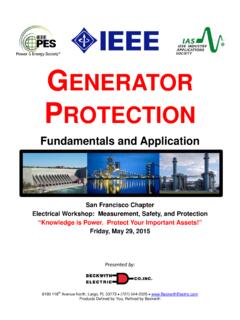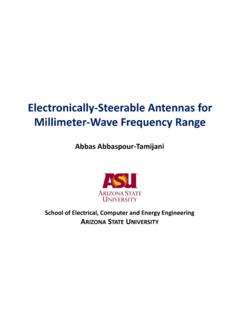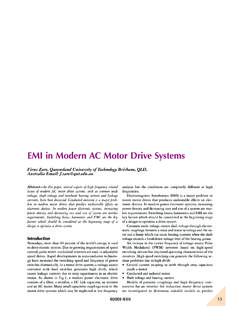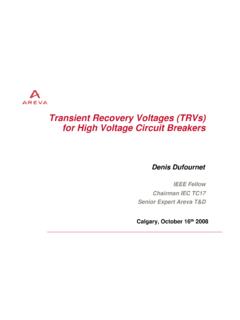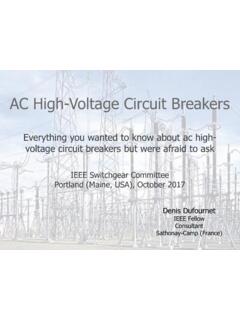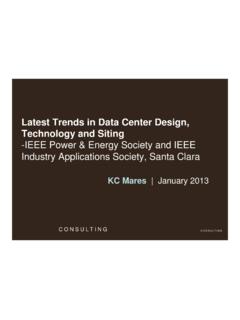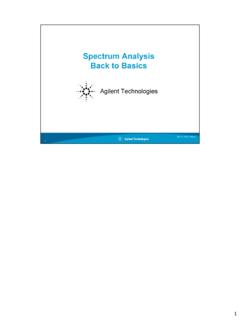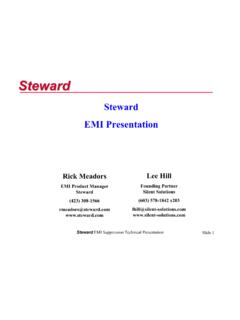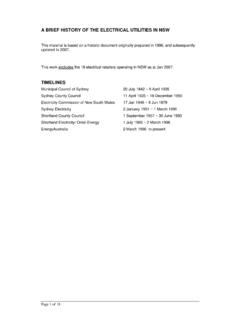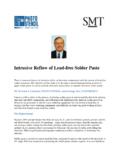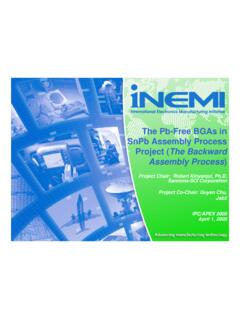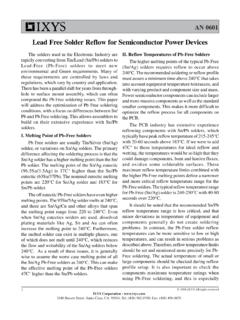Transcription of Lead-free Soldering Materials and Processes - IEEE
1 Peter Biocca Senior Market Development EngineerKester, Itasca, IllinoisLeadLead-- free Soldering free Soldering Materials and Processes Materials and Processes Requirements to Make Them WorkThis presentation is only a summary RoHS Globally - Latest Update Materials - Components and Boards Solders - Lead-free Choices Lead-free SMT Process Preventing Defects in SMT LF Wave Soldering Process Preventing Defects in Wave Assembly LF Hand Soldering and ReworkThe information contained in this presentation is accurate as per the industry information available at the time of this revision. Please obtain the latest information for your process needs since Lead-free assembly requirements may WEEE Directives Re/ WEEE Directives Re--CapCap Reduce and eventually eliminate the use of prohibited substances at the source (RoHS) Maximum permissible levels in a homogeneous material will be as follows: Cadmium (Cd) 100 ppm Mercury (Hg) 1000 ppm Lead (Pb) 1000 ppm Hexavalent chromium (Cr(VI))1000 ppm Polybrominated Biphenyls1000 ppm Polybrominated Diphenyls Ether 1000 ppm Recycle as much of the product as possible after its useful life, in order to minimize the issues of disposal (WEEE).
2 Very much a recycling presentation by Dan Shea, CMAP International Lead-free Conference, Toronto, Canada May presentation by Dan Shea, CMAP International Lead-free Conference, Toronto, Canada May exemptionsAdditional exemptionsEC Stakeholder Consultation 2002/95/EC Lead in tin whisker resistant coatings for fine pitch applications Solders containing Lead and Cadmium for special applications Lead in connectors, flexible PCB s, flexible flat cables Low melting point alloys containing lead Applications of lead, mercury, cadmium, , PBDE, PBB s in aerospace and aeronautical applicationsRoHSRoHSDirective: Substance LimitsDirective: Substance Limits Maximum Concentration Values in weight percent for Pb, Hg, hexavalent Cr for Cd for PBB and PBDE flame retardants Concentration is per homogeneous material Homogeneous material means a material that cannot be mechanically disjointedlead-framelead-frame coatingsoldercopper board finishboard surface finishcopperglassepoxyNot Just EuropeNot Just EuropeJuly 2003 End 2005 for assembliesJGPSSI Guidelines for Standardization of material DeclarationJEITA Lead-free RoadmapJanuary 2007 VariousCalifornia RoHS-equivalency measures52 bills pending in 20 statesMarch 2007 Regulation for pollution control of Electronics Products (RPCEP)July 2006 Reduction of Hazardous Substances (2002/95/EC)
3 Compliance TimingRegulationPresented at the International Lead-free Conference, Toronto, Canada, May TheCalifornia Department of Toxic Substances Controlwill hold a public workshop this week to solicit input and update stakeholders on the development of regulations prohibiting the sale of non-RoHS compliant electronic devices in workshop will be held Nov. 9, at the CalEPA Building in Sacramento. A remote videoconference will take place in Glendale, CA. All interested parties are invited to Linda Sargent at or Cindy Chain-Britton at or call event will also be accessible via a live audio webcast on the Cal/EPA website at Questions and comments may be submitted in real time and will be considered when DTSC finalizes the regulation in 2007, a California law will ban the sale of some electronic devices that contain certain hazardous Electronic Waste Recycling Act (EWRA), which was signed into law in September of 2003, requires the DTSC to adopt regulations toprohibit covered electronic devices from being sold or offered for sale in California if they are prohibited from sale in the European Union under the RoHS Directive because they contain certain heavy of December 2005, DTSC had identified eight categories of covered electronic devices in its regulations.
4 The list of covered devices includes:1. Cathode ray tube containing devices (CRT devices)2. Cathode ray tubes (CRTs)3. Computer monitors containing cathode ray tubes4. Laptop computers with liquid crystal display s5. LCD-containing desktops6. Televisions containing cathode ray tubes7. Televisions containing LCD screens8. Plasma EWRA will restrict the use of lead, mercury, cadmium, and hexavalent chromium in electronic devices sold in California. The RoHSDirective was amended on Aug. 18, 2005, to add maximum concentration values for the six restricted substances. DTSC will incorporate the EU s MCVs for lead, mercury, cadmium, and hexavalent chromium in its regulations implementing the s RoHS regulations will recognize any exemptions adopted by the EU for the use of lead, mercury, cadmium, or hexavalentchromium that apply to covered electronic will present the proposed RoHS regulations and solicit comments and suggestions from In the News, November 2006, California Summary Key Procurement Issues for Key Procurement Issues for RoHSRoHS Components Boards Solders and fluxes Wires and cables Metal fixtures and fasteners Plastic parts, casings ( Lead-free ):Electrical and electronic assemblies and components in which the Lead (Pb) level in any of the raw Materials and the end product is <= by weightand also meets any Pb- free requirements/definitions adopted under the RoHS Directive 2002/95 Note.
5 A Pb- free component may not necessarily becompatible with Pb- free processing temperatures, as process-compatibility must be determined by the Maximum Safe Temperature LeadLead-- free free IPC/IPC/JEDEC JEDEC DefinitionDefinitionJEDEC Standard JEDEC Standard JESD97 or IPCJESD97 or IPC--10661066 Pb- free category: Assigned to Pb- free components, boards, and assemblies indicating the general family of Materials used for the 2nd level interconnect including solder paste, lead/terminal finish, and terminal material /alloy solder balls e1: SnAgCu e2: Other Sn alloys no Bi or Zn (SnCu, SnAg, SnSb) e3: Sn e4: Pre-plated (Ag, Au, NiPd, NiPdAu) e5: SnZn, SnZnx (no Bi) e6: Bi e7: Low Temp.< 150 C, In based, no Bismuth e8, e9 unassigned Tin-lead boards and components have no assigned labelChoosing the Materials For Pb- free and Directives ComplianceSummarizing the Key Points on Summarizing the Key Points on ComponentsComponents Lead-free termination finish RoHS compliancy, metal finishes and plastics Thermal compatibility Moisture sensitivity ratingComponent LF FinishesComponent LF FinishesNote: If your not transitioning do check Note: If your not transitioning do check what you are you are surprises.
6 Avoid surprises. Ni alloys: Ni/Kovar, Alloy 42, difficult to solder Pd/Ni: Palladium acts similar to Au as a oxidation Pd/Ni/Aginhibitor, different metallic combinationsavailable Pd/Ni/AuLow ductility Cracking a problem, More expensive SnBi: Can t mix with Pb, low mp phase at 97 C Pure Tin: Whisker potential, especially fine pitch components SnAg: Tight plating control required SnCu: Tight plating control required Many others finishes available Add a small amount of Cu or Ag to tin Use of nickel barrier between copper and tin* Use matte tin(larger grain deposits), instead of fine grain bright tin finish Use of thicker tin coat 8-12 micrometers Reflow of surface prevents whisker growth Anneal process Newer anti-whisker fine grain matte tin finishes, example Technic Advanced Technologies, TechStan EP* Studies seem to indicate this to be the most effective way to minimize whiskers. Ways to Prevent Ways to Prevent Tin WhiskersTin WhiskersMoisture/Reflow Sensitivity Classification for Nonhermetic Solid State Surface Mount Devices Establishes new Lead-free max.
7 Processing temperatures Minimum and Maximum thermal profile requirements Moisture Sensitivity Level (MSL rating) classification criteriaHigher processing temperatures for Lead-free assembly increases risks of: Internal delamination Internal cracks Bond damage, die lifting, thin film cracking, popcorning Cratering External package cracksIPC/JEDEC JIPC/JEDEC J--STDSTD--020C020 CResults of Improvements to Materials (PBGAs)Ref : Pb- free IC Component Issues and IPC/JEDEC Specification Update, Rick Shook, Agere SystemsImpact of Impact of LeadLead-- free on MSDfree on MSDS ummarizing Key Points on Summarizing Key Points on BoardsBoards Lead-free board finishes RoHS compliancy for laminates RoHS compliancy for solder mask Thermal compatibility, up to 260 C Changes to Tg and Td ComponentComponent--Board Board Process CompatibilityProcess Compatibility Termination and board finish choices Thermal compatibility Plastics, molding compounds for components, etc RoHS compliancy, all levels Moisture sensitivity levels of SMD s Availability, Cost Shelf-life and logistics Proposed Test Flow Procedure or RoHS SubstancesProposed Test Flow Procedure or RoHS SubstancesRepresentative Sample or Object to be testedScreening with EDXRFRoHS CompliantCr, Hg, Pb < 700ppm Cd < 70 ppm, Br <350 ppmMethods:HPLC, GC/MSMethods:UV VisMethods.
8 EDXRFAASICP-OES CdHg, Pb >1300ppmCd > 130 ppmRoHS NonCompliantInconclusiveMethods: EDXRFAASICP-OES Methods: EDXRFAASICP-OES PBB/PBDECr+6 HgPbCr > 700, Br > 350 Electronic Related Applications XRFE lectronic Related Applications XRF Due Diligence Verify Certificates of Analysis and Supplier Declaration Spot check your high risk vendors Reduce amount of money spent on outside lab testing Identification of prohibited material Analysis of Pb and other elements for prevention of tin Whiskers RoHS Exempt products Medical Military Long-Life applicationsX-ray Fluorescence UnitLeadLead-- free solder SelectionFree solder SelectionAlloy Selection OverviewAlloy Selection Overview Alloy selection, choosing the solder to suit the end in mind Must consider MP, alloy strength, ductility, reliability data, availability, patents, etc. Current trends are toward SAC system for SMT Current trends are toward SAC or Sn/Cu system for wave solderingCommon LF AlloysCommon LF Alloys SnAgCu (or SAC ) family(MP = ~217C) Many available varieties with different proportions of Sn, Ag & Cu (MP = 221C) Sn/Ag Eutectic alloy family(MP = 227C) Sn/Cu Eutectic alloy, plus Nickel or Germanium, Bismuth Sn99 (MP = 217-227C) Lower cost SAC alloy due to lower Silver content6060404020201010 SAC67%SnAg13%SnAgBi10%SnAgCuBi6%SnZnBi 3%SnCu 1%SAC alloy popular in SMTSAC alloy popular in SMTR eflow solder Selection on a Reflow solder Selection on a Global BasisGlobal Basis (SAC305) , iNEMI alloy Cu , fading away Cu , European favorite4040303020201010 SAC42%SnCu25%SnAg8%SnBi4%Undecided21%Oth er Global Wave solder SelectionGlobal Wave solder SelectionUndecided mostly between SAC or SnCu based Increasing useSAC305 for WaveSAC305 for Wave (MP ~217C)
9 Popular wave Soldering alloy Highest cost More data available Good reliability Cosmetic issues SAC0307 for WaveSAC0307 for Wave Sn99 (MP 217-227C) Lower-Silver version of traditional SAC alloys for lower cost Originally used as a plumbing solder , little data for electronics applications Could be worth considering in some applications as a replacement for SAC305 with lower costSnSn/Cu based solders for Wave/Cu based solders for Wave eutectic point of this binary system (MP 227 C) Low cost alternative to SAC305 for wave SnCu with additives, Nickel, Gallium, Cobalt, Bismuth SnCuNi an option, several alloys here These Materials are lower in cost and reliability data is still being collectedAlloy Selection ReworkAlloy Selection Rework Rework: Match rework alloy to alloy used to produce original joint Other Hand Soldering : Match alloy to whatever is already used on the boardJust a word on Just a word on Surface Shrinkage EffectsSurface Shrinkage Effects As mentioned in JAs mentioned in J--STDSTD--610D, Chapter 5610D, Chapter 5 Typically seen with SAC solders in wave, selective and hand-solderingNot seen in Not seen in SnCuSnCubased solders based solders such as K100, K100LD, SN100C such as K100, K100LD, SN100C 63/37 K100 K100LD SAC solder Shrinkage SAC305 solder Shrinkage SAC305 After 500 thermal cycles, iNemi Lead-free Wave Project 2006.
10 LeadLead-- free free SMT AssemblySMT AssemblySMT Impact on ManufacturingSMT Impact on Manufacturing Screen Printing and Paste Dispensing Little change, rheological properties do not change, lower metal % Pick & Place Equipment Little impact. Better placement accuracy may be needed due to less self centering of lead free alloys when molten AOI Recalibration; joints are duller in appearance and less reflective Reflow Significant impact due to higher melting alloy temperatures Inspection, changes due to cosmetics and wetting characteristics ICT changes due to no-clean flux residue hardeningKester Lead free Reflow ProfileAlloys: and (sec.)Temperature (C)Pre-heating Zone( min. max.)Soaking Zone( )60-90 s e c. typicalReflow Zonetim e above 217 C(90 s e c m ax)60-75 s e c. typicalPe ak Te m p. 235 - 255 C< C/SecTypical profile for SAC in Air or N2 LeadLead-- free Reflow Profilefree Reflow ProfileNew New LF solder Paste Flux are RequiredLF solder Paste Flux are Required New activators New resins New gelling agents Better surfactants Oxidation inhibitors Alloy specific fluxesBelow two Lead-free SAC pastes heated to 180 C, showing different slump behaviorsResidue impacts ICT, cosmetics andcleaning and sometimes reliabilityChoose the right paste for the jobLittle changeChange solder Paste Qualification solder Paste Qualification Ask for more informationAsk for more information Print speed Abandon time Stencil life Tack life solder ball potential Slump behavior Metallization Spread Reflow window Voiding potential Double reflow Cleanability, if W/S Pin testability, if N/CSame alloy, flux class.
